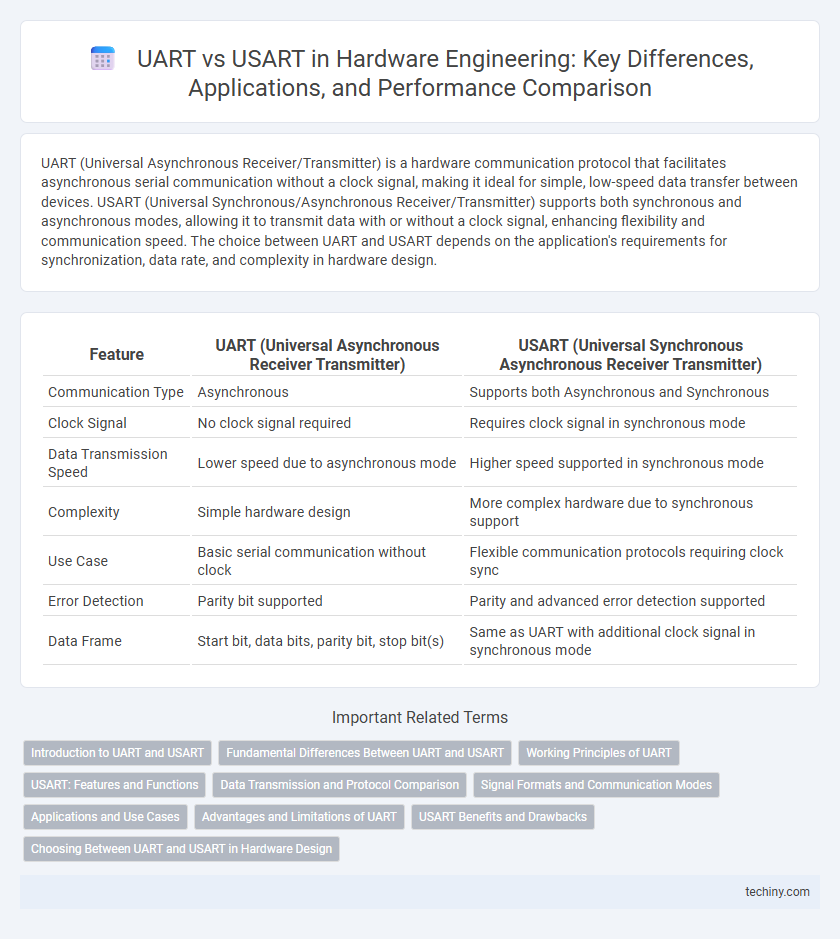UART (Universal Asynchronous Receiver/Transmitter) is a hardware communication protocol that facilitates asynchronous serial communication without a clock signal, making it ideal for simple, low-speed data transfer between devices. USART (Universal Synchronous/Asynchronous Receiver/Transmitter) supports both synchronous and asynchronous modes, allowing it to transmit data with or without a clock signal, enhancing flexibility and communication speed. The choice between UART and USART depends on the application's requirements for synchronization, data rate, and complexity in hardware design.
Table of Comparison
| Feature | UART (Universal Asynchronous Receiver Transmitter) | USART (Universal Synchronous Asynchronous Receiver Transmitter) |
|---|---|---|
| Communication Type | Asynchronous | Supports both Asynchronous and Synchronous |
| Clock Signal | No clock signal required | Requires clock signal in synchronous mode |
| Data Transmission Speed | Lower speed due to asynchronous mode | Higher speed supported in synchronous mode |
| Complexity | Simple hardware design | More complex hardware due to synchronous support |
| Use Case | Basic serial communication without clock | Flexible communication protocols requiring clock sync |
| Error Detection | Parity bit supported | Parity and advanced error detection supported |
| Data Frame | Start bit, data bits, parity bit, stop bit(s) | Same as UART with additional clock signal in synchronous mode |
Introduction to UART and USART
UART (Universal Asynchronous Receiver/Transmitter) is a hardware communication protocol used for asynchronous serial communication, enabling data exchange between microcontrollers and peripheral devices without a clock signal. USART (Universal Synchronous/Asynchronous Receiver/Transmitter) supports both asynchronous UART communication and synchronous serial communication by incorporating an external clock, allowing higher data transfer rates and greater flexibility. Both UART and USART are integral in embedded systems for serial data transmission, but USART offers enhanced functionality for time-critical applications.
Fundamental Differences Between UART and USART
UART (Universal Asynchronous Receiver/Transmitter) operates solely in asynchronous mode, transmitting data without a clock signal, while USART (Universal Synchronous/Asynchronous Receiver/Transmitter) supports both synchronous and asynchronous communication, allowing data transmission with or without a clock. UART handles start and stop bits to frame data for asynchronous transfer, whereas USART can use clock pulses to synchronize data bits in synchronous mode, increasing data transfer reliability and speed. The hardware complexity and application flexibility of USART make it suitable for environments requiring both communication modes, unlike the simpler UART which is limited to asynchronous serial communication.
Working Principles of UART
UART operates by converting parallel data from a microcontroller into serial form for transmission through a single communication line, using start, stop, and parity bits to frame the data packets. It functions asynchronously, relying on agreed-upon baud rates between transmitter and receiver for accurate timing without a shared clock signal. The simplicity of UART makes it ideal for short-distance, low-speed serial communication in embedded systems.
USART: Features and Functions
USART (Universal Synchronous/Asynchronous Receiver Transmitter) supports both synchronous and asynchronous communication modes, enabling flexible data transmission in hardware engineering applications. It offers enhanced features such as clock synchronization in synchronous mode, which improves data integrity and transmission speed compared to UART. USART includes configurable baud rates, multi-processor communication, and error detection mechanisms like parity, making it ideal for robust serial communication in embedded systems.
Data Transmission and Protocol Comparison
UART (Universal Asynchronous Receiver Transmitter) transmits data asynchronously without a clock signal, relying on start and stop bits for synchronization, while USART (Universal Synchronous/Asynchronous Receiver Transmitter) supports both asynchronous and synchronous transmission modes, enabling synchronous data transfer with a shared clock. Data transmission speed in USART can be higher due to clock synchronization, reducing timing errors compared to UART's asynchronous format. The protocol comparison highlights USART's versatility in handling multiple communication standards, whereas UART is simpler and widely used for basic serial communication.
Signal Formats and Communication Modes
UART supports asynchronous communication with standard baud rates and uses start, data, parity, and stop bits for signaling. USART offers both asynchronous and synchronous modes, enabling clocked communication with additional control signals like clock polarity and phase. Signal formats in USART allow greater flexibility for data framing, making it suitable for diverse hardware interfaces.
Applications and Use Cases
UART is widely used in simple serial communication applications such as GPS modules, Bluetooth devices, and microcontroller interfaces due to its asynchronous transmission capability. USART supports both asynchronous and synchronous communication, making it ideal for applications requiring higher data rates and precise timing, such as embedded systems, industrial automation, and communication protocols like SPI and I2C. Choosing between UART and USART depends on the specific requirements of data speed, synchronization, and compatibility with peripheral devices.
Advantages and Limitations of UART
UART (Universal Asynchronous Receiver/Transmitter) is widely favored for its simplicity and ease of implementation in hardware communication, requiring fewer components and no clock signal, which reduces overall system complexity and cost. Its main limitation lies in the lack of synchronization, making it less suitable for high-speed data transfer or environments with significant electromagnetic interference compared to USART (Universal Synchronous/Asynchronous Receiver/Transmitter). UART's asynchronous nature restricts data integrity over long distances, while its straightforward protocol is ideal for low-speed, short-range serial communication in embedded systems.
USART Benefits and Drawbacks
USART offers flexible communication by supporting both asynchronous UART mode and synchronous modes, enabling higher data rates and improved clock synchronization. Its ability to handle full-duplex communication enhances data throughput in embedded systems, making it ideal for time-critical applications. However, USART complexity and power consumption are higher compared to UART, potentially limiting its use in low-power or simple serial communication scenarios.
Choosing Between UART and USART in Hardware Design
Choosing between UART and USART in hardware design depends on communication requirements and protocol flexibility. UART (Universal Asynchronous Receiver Transmitter) is ideal for simple asynchronous serial communication without clock signals, offering ease of implementation and lower hardware complexity. USART (Universal Synchronous/Asynchronous Receiver Transmitter) supports both asynchronous and synchronous modes, enabling higher data rates and precise clock synchronization, making it suitable for applications demanding faster and reliable data transfer.
UART vs USART Infographic

 techiny.com
techiny.com